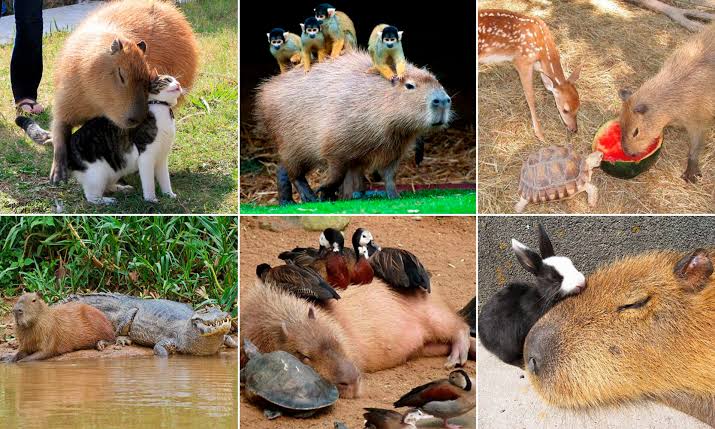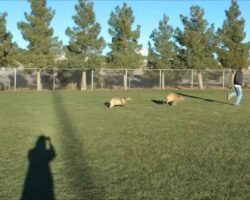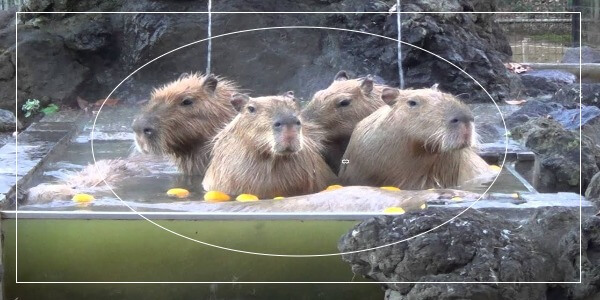Capybaras are not the fastest animals in the wild but they have the tendency to flee quickly at the sight of predators. Capybaras are known for their large size, making them a big kill for predators.
Capybaras are blessed with long legs that are incredibly fast and their powerful claws give them a strong grip while running. Moreover, their muscular body helps them outrun the most threatening predators.
While running, these rodents can reach a maximum speed of 35kph. Their speed coupled with their swimming ability helps them keep away from danger. Capybaras are great climbers – all thanks to their sharp claws, which give them a firm grip on trees and their branches.
In this article, we will look at the capybaras’ speed and how fast they can run. You will also learn how capybaras escape predators and how they survive in the wild.
What is a Capybara?
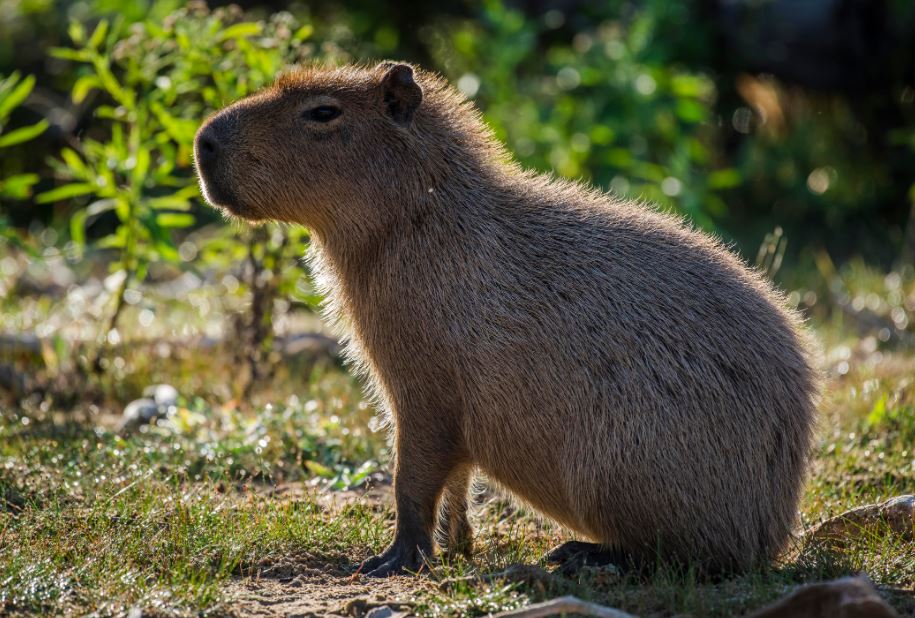
Capybaras (Hydrochoerus hydrochaeris) are the largest rodents in the world. They come from South America and can be seen in high numbers in Brazil, Ecuador, Columbia, Argentina, Uruguay, and Periu. They also live in other parts of the world, including China, Canada, the U.K., and the United States of America.
The capybara typically measures around 39 to 55 inches (100 to 140 cm). They have small ears and webbed feet, which are great for running and swimming. You can identify a capybara from other rodents if it has reddish-brown fur, short limbs, a barrel-shaped body, and webbed feet.
They are herbivores and feed mainly on aquatic plants, fruits, grasses, and leaves, and can also consume small reptiles and insects. Capybaras are heavy eaters, they need to eat constantly to stay fresh and healthy. Due to their large appetite, these rodents can weigh anywhere around 60 to 160 pounds.
Capybaras are semi-aquatic animals and are commonly seen in water bodies like ponds, rivers, lakes, and streams. Apart from water bodies, these rodents can adapt to other terrains such as forests, wetlands, marshes, swamps, etc.
Ideally, capybaras love staying in places with water bodies available. They are excellent swimmers and can immerse themselves underwater for many minutes if they see potential predators close by.
Capybaras can be found in the day, probably in chilling in a pool of water but they are more active at night.
Capybaras are social, as they love to form bonds and associations within themselves. It’s rare to find a solitary capybara except if such a capybara is aggressive or dangerous. Capybaras are friendly animals and live together. It’s common to see capybaras living in groups of 20, 40, or more than 100.
How Fast Can a Capybaras Run?
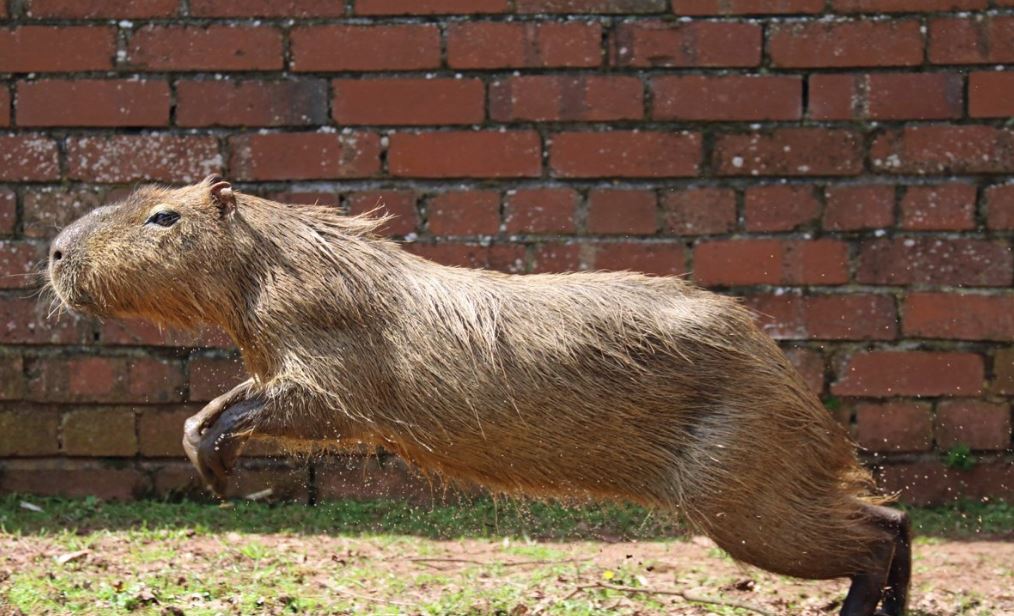
While capybaras are the world’s largest rodents, they are not the fastest animals on land. For the records, the cheetah is the world’s fastest animal on land, as it can reach speeds of 120 kilometers per hour (75 mph).
Capybaras are fast runners and can reach incredible speeds of 24 to 35 kilometers per hour (15 to 22 mph). Considering its large size, it may be surprising to know that capybara are faster than most humans.
If you are hunting a capybara, it is crucial to have a strategy in place because your speed isn’t enough to beat them.
They are agile and fast enough to escape from danger when they sense one. They can make sharp turns and twists to evade danger. Their impressive running speed makes it difficult for predators like ocelots, leopards, and jaguars to catch them.
Some of the factors that affect the running speed of a capybara include:
- Age: Younger capybaras are agile and quicker than the old ones.
- Terrain: Capybaras run faster on smooth and even terrains but slippery, uneven, and muddy terrains can negatively affect their speed and overall running performance.
- Motivation: The presence of a predator can boost the speed of a capybara, as it seeks safety.
- Health: The health condition of a capybara also affects its running performance. A capybara in good shape is expected to outrun a sick capybara.
Away from land, they also use their speed in water and can swim away from predators. Additionally, their speed also helps them hunt fish and other aquatic animals.
Why Do Capybaras Run?
Capybaras are calm but can be found running, for many reasons. Whenever you see a capybara running, you can tell it’s searching for food or running from something.
Capybaras are smart enough to exploit their speed to their own advantage. They can cover expansive areas of land in search of food.
The earlier they access food sources, the higher their chances of survival. The reason is that capybaras have a large appetite and find it difficult to starve themselves. Finding food sources on time will help them save energy.
When they come across grasslands, they explore the area to know if the vegetation is safe for consumption or if the terrain is home to predators.
Also, they use their speed to make quick turns and maneuvers to prevent being eaten by predators. Below are some reasons why capybaras run:
1. Socialization
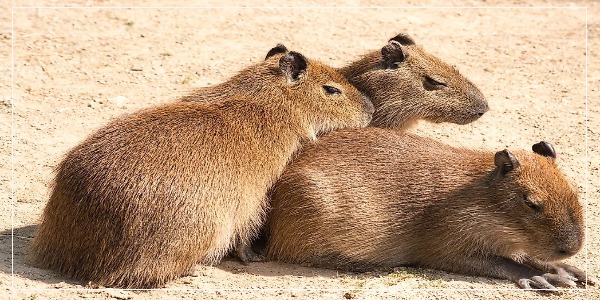
Capybaras are social with themselves and other animals. You can find capybaras living in grounds called “herds” and they have different ways, which they use to communicate among themselves.
Capybaras can participate in sports among themselves and play with one another. You can find them swimming and running with themselves.
2. Evade Dangerous Predators
Capybaras have several predators that hunt them for food. Large snakes such as anacondas and other animals such as caimans, ocelots, pumas, and jaguars can eat a capybara.
Their first line of action after seeing the predators is to flee. Capybaras are too fast and can run over 10mph. Their running abilities help them evade predators and find a place of safety.
When a capybara sights a predator, it raises an alarm and the entire herd scampers for safety. A capybara can also use other mechanisms to defend itself when threatened or attacked. Its sharp teeth can leave deep cuts in the flesh or any potential attacker.
3. Food
As herbivorous animals, capybaras graze large fields every day for food. These rodents consume large quantities of grasses, fruits, and aquatic plants to survive.
When searching for food, capybaras may travel long distances to find the best grasses and leaves to eat. Thanks to their impressive running speed of 10mph, they can cover a large area and find the best grassland to feed on.
Although capybaras aren’t the fastest animals on land, their fast legs are reliable for helping them find food and steer away from potential dangers.
Capybara Anatomy and Physiology
Capybaras have a unique structure that makes it easy for them to make swift movements or run fast. These large rodents have short legs covered in thick fur that propels them to run quickly.
Their large, muscular chest and hindquarters are invaluable assets to them as they help them thrust forward.
Their long, flattened tails do two tasks – first, it provides balance and secondly, it acts as a rudder while they swim or run, helping them to make sharp turns and twists while running or swimming to evade predators or source for food.
They have a flexible spine, which acts as a shock absorber while running and helps them slow down when necessary. This helps them prevent injuries while running and also saves energy for other activities.
Furthermore, capybaras have a unique respiratory system that is different from other rodents. Capybaras have large lungs and extra air sacs in their nose that help draw air into the lungs.
Their vision and hearing are excellent, as it helps them detect predators and flee when possible. They have large eyes that help them identify predators from a distance.
When a capybara needs to run after seeing a predator, its heartbeat rate increases. They can create deep burrows to conceal themselves and their young ones. Their thick coat of fur keeps them warm and maintains their body temperature especially when during the winter season.
Capybara boasts powerful legs that help them move quicker on land and in water. Their webbed feet make them excellent swimmers.
How Fast Can Capybaras Be?
As mentioned, capybaras are fast animals. These creatures can run as fast as 10 miles per hour if threatened. On average, a capybara (young and old) can run up to 6 mph.
Capybaras are fast but may be moved swiftly on muddy and uneven terrains. However, they can maintain a pace of 5 miles per hour on uneven terrains.
Their powerful legs and feet contribute to their speed. The capybara’s diet also plays an important role in its running speed.
The capybara enjoys a rich diet composed of water plants, grasses, leaves, and natural vegetation. Consuming aquatic plants in huge quantities provides them with enough energy, strength, and stamina to run faster.
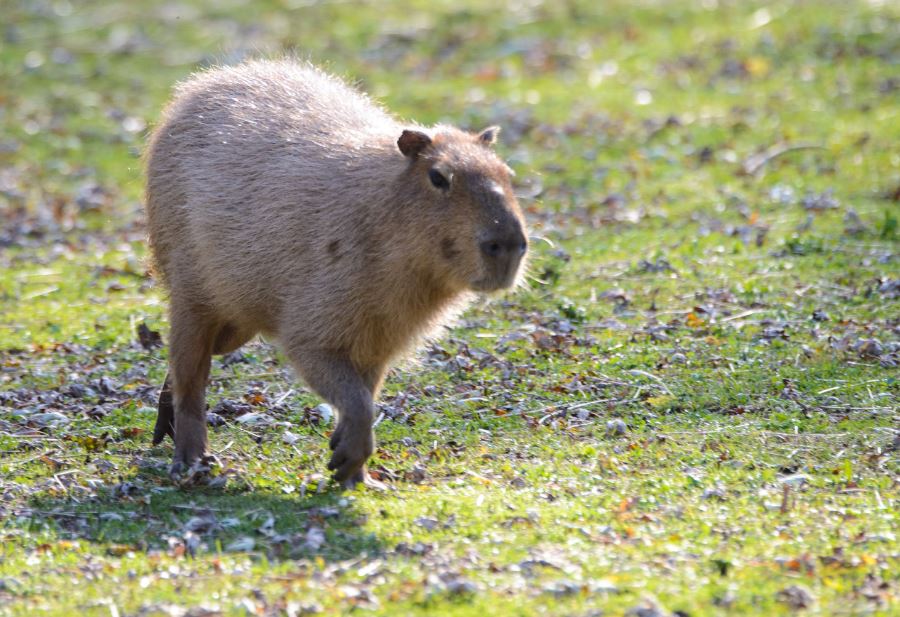
These large rodents can sustain a speed of 10mph for 3 minutes or more, especially when threatened by predators. The capybara’s running speed is unusual for an animal of its size. It is often said that capybaras are quicker than humans. Their webbed feet give them increased grip and firmness over the surface area of the terrain while running.
If you own a capybara, it will be great to let it explore your garden or yard if you have one or take it to a field to witness its fast speed.
It is important to keep your pet capybara in a place where it has plenty of space to move around. Doing this constantly will make it happy and lively. Also, it will make your capybara friendly and less aggressive to other capybara that are locked up in homes.
Frequently Asked Questions
Are capybaras fast?
Capybaras are fast animals; they have a set of feet that can outrun most predators in the wild. On average, capybaras can run over 35 kilometers per hour.
Their running speed is so important because it helps them escape danger. They also use their speed to search for find in forests and grasslands.
Capybaras need to eat a lot of grasses and plants to gain energy and stamina, so they tend to relocate or move to places where they can find nutritious plants.
Why do capybaras run so fast?
Capybaras have incredible legs and feet that keep them stable on the ground while running. These rodents run when attacked or threatened.
Fleeing from danger is the first line of defense a capybara will produce when faced with danger. While fleeing, it runs in a zigzag pattern to a place where it can stay hidden, away from the eyes of the predator.
Capybara runs to survive. if it thinks it has been spotted, it leaves that terrain and runs to a place where it won’t get attention from predators.
How fast can capybaras swim?
Capybaras are excellent swimmers. They can swim over 30kph. Their tail, webbed feet, and muscular bodies help them navigate through the water.
One of the notable capybaras facts is that they can hold their breath and stay underwater for over 30 minutes.
Conclusion
Capybaras have unique body features that make them fast on land and water. They may not be the fastest animals in the one, but their speed is top-notch for a rodent.
Capybara have excellent running speeds and their swimming ability is impressive as well. If you have a pet capybara, it is important to know the speeds of the animal and be cautious, especially when it is grazing in your garden.
If there are capybaras in your neighborhood, you must take precautions to prevent them from accessing your farm and potentially damaging your plants.
Capybaras are smart and their brains tell them when to run for safety. Capybaras are shy and can flee when they see strange faces. Their running ability is an asset to them as it helps them get away from predators, find food, and form alliances among themselves.

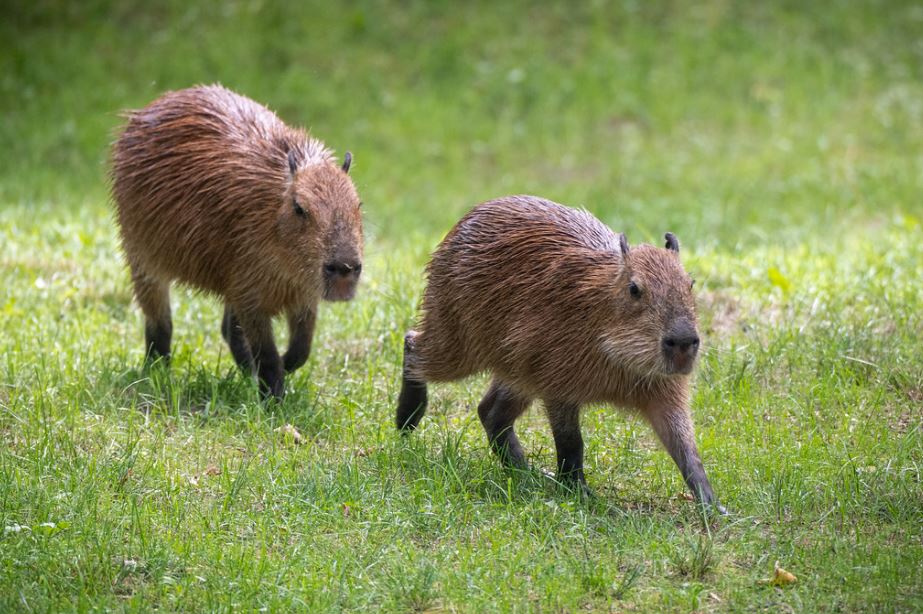
![Why Do Capybaras Not Have Tails? - [Answered] Why Do Capybaras Not Have Tails](https://capybaratips.com/wp-content/uploads/2023/03/Capy-Tail-250x200.webp)



